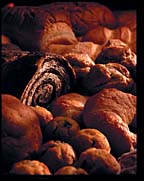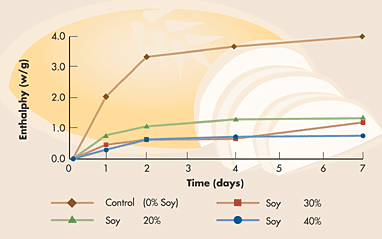Emulsifiers
By using a surfactant, such as an emulsifier, one can create an emulsion of two or more incompatible substances. A typical emulsion is a dispersion of small droplets of one immiscible liquid within another. Emulsifiers keep the droplets from coalescing. These ingredients not only offer emulsification, but also starch complexing, protein strengthening and aeration in baked goods.
Emulsifiers are used in bread to extend shelf life by slowing down the staling process. Bread tastes and feels stale when it starts to taste like cardboard, and feels dry and hard. In the laboratory, staleness can be measured by the crumb's resistance to compression, with an instrument such as the Instron Universal Testing Machine.

Rather than producing an initially softer crumb, as previously believed, emulsifiers interfere with the recrystallization (or retrogradation) of amylose, which retards the firming rate. The fatty acid-end of emulsifiers forms a complex with gelatinized starch to slow down starch recrystallization and the staling process in bread. (See chart on page 42.)

Lecithin
Lecithin, a primary emulsifier in egg yolks, also can be derived from rice and other grains. Soy-based lecithin, which contains phospholipids, is a by-product from the refining of crude soybean oil. The four main components of soy lecithin include phosphatidylcholine, phosphatidylethanolamine, phosphatidylinositol, and phosphatidic acid. Soy-based lecithin has a more healthful image than some other emulsifiers.With lecithin's hydrophobic and hydrophilic portions, it can simultaneously interact with both oil and water, making it an effective emulsifier. In addition, lecithin aids in machinability and shortening dispersion of baked goods. Various types of lecithin are available to bakers including fluid, deoiled (hydrophilic), chemically-modified (acetylated/hydroxylated), enzyme-modified (EM) and powdered versions of these.
Considerations for selecting lecithin are specific benefits, labeling requirements and handling procedures. Fluid lecithin is a viscous, syrupy, amber-colored liquid. Bakers prefer powdered lecithin. It is easy to incorporate with dry ingredients and is convenient to add to dry mixes.
Powdered, deoiled lecithin, commonly used in breads, has less flavor than fluid lecithin, is higher in phospholipid content, and is water dispersible. Standard fluid lecithin contains about 30% soybean oil, with deoiled lecithin containing 2% or less, says Karen Allen-Seabolt, associate scientist with Central Soya Co., Inc., Lecithin Group, Fort Wayne, Ind. Usage level is about 0.5 to 1.0% on a flour weight basis.
“We have different forms of lecithin to help increase volume and dough strengthening, and to extend shelf life,” says Seabolt. “Deoiled, non-modified lecithin helps improve crumb structure and volume, but it doesn't help as much as enzyme—modified lecithin with shelf life for yeast-raised products.”
Deoiled lecithin is more concentrated in phospholipids—the active, functional component of lecithin—than fluid forms, according to Bruce Sebree, Ph.D., manager of Emulsifier and Texturant Technology, ADM Research, Decatur, Ill. In most formulations, deoiled lecithin can replace standard fluid at two-thirds usage rate, he adds. EM lecithin performs similarly to monoglycerides because it will form a complex with starch more readily.
“In enzyme-modified lecithin, the middle-position fatty acid is removed from the phospholipid with a phospholipase enzyme,” says Seabolt. “It is replaced with a hydroxyl group, making the molecule more polar, which increases its ability to complex with starch. EM lecithin is used mainly for yeast-raised baked goods to extend shelf life, but it also improves volume with its ability to act as a dough strengthening agent.”
EM lecithin can replace mono-glycerides. Its use in bread is becoming more popular with bakeries today, adds Seabolt.


Sidebar: OSU Researchers Formulate Tasty Soy Bread
Rather than relying on a nutritional bar or a beverage, researchers at Ohio State University (OSU) are hoping that consumers will consider an everyday food to get soy into their diets—bread.One large slice or two slices (50g) of the bread contains 6.25g of soy protein per serving, which meets the soy protein health claim criteria.
“I didn't start looking for health claims—I became interested in adding soy to bread formulations and comparing wheat bread and soy breads because staling seemed to be retarded with the addition of soy flour to wheat flour,” says Yael Vodovotz, assistant professor of food science at Ohio State University and co-author of the book, Bread Staling. (CRC Press, 2000).
Vodovotz found adding soy to bread decreases amylopectin recrystallization significantly, increasing the soy bread's shelf life.
The bread contains flour made from hard red wheat and two soy-based ingredients—soy flour and soymilk powder. While loaf volume decreases with an increase in soy flour, soymilk helps increase the loaf volume and has a positive flavor impact, says Vodovotz. Adding mono- and di-glycerides—as well as some fat—helps increase the loaf volume by lubricating the dough system and increasing the flexibility of the intercellular structure. A dough strengthener, L-cysteine, boosts internal structure.
A consumer acceptability study by Cory Ballard, an OSU undergraduate and senior food technologist for Chef-Con, Delaware, Ohio, found that 70% of those who participated in in-store sensory tests preferred the flavor of soy bread to that of red wheat bread. “Kids really liked the soy bread because it's sweet,” says Ballard.
In another study A.S. Colakoglu, an OSU student, investigated “The effect of soy on the thermal and mechanical properties of bread during storage.” Differential Scanning Calorimeter (DSC) studies showed that the addition of soy flour (20%-40% substitution) to wheat flour decreased the amount of “freezable” water and amylopectin recrystallization, which can be interpreted to say that adding soy flour retards staling.
OSU is licensing the formula to bakeries for sale in mainstream supermarkets. Researchers at the OSU medical school want to test the bread's cancer-control potential.
Links
- PF article overview on science of emulsifiers and processing
- AACC abstract on consumer acceptability of soy bread
- Press release on heart-healthy soy bread
- French Meadow Bakery, Minneapolis, Minn.
- Alvarado Street Bakery, Rohnert Park, Calif.
- PF article on soyfood
- AACC abstract on soy's effect on bread properties during storage